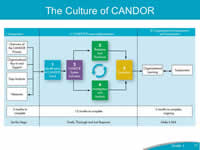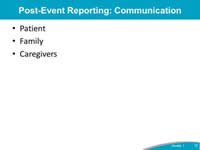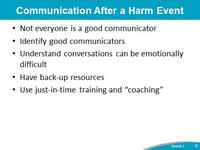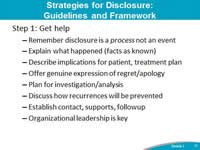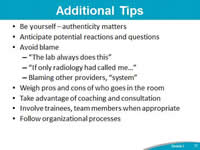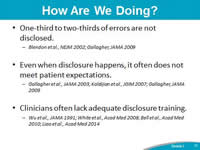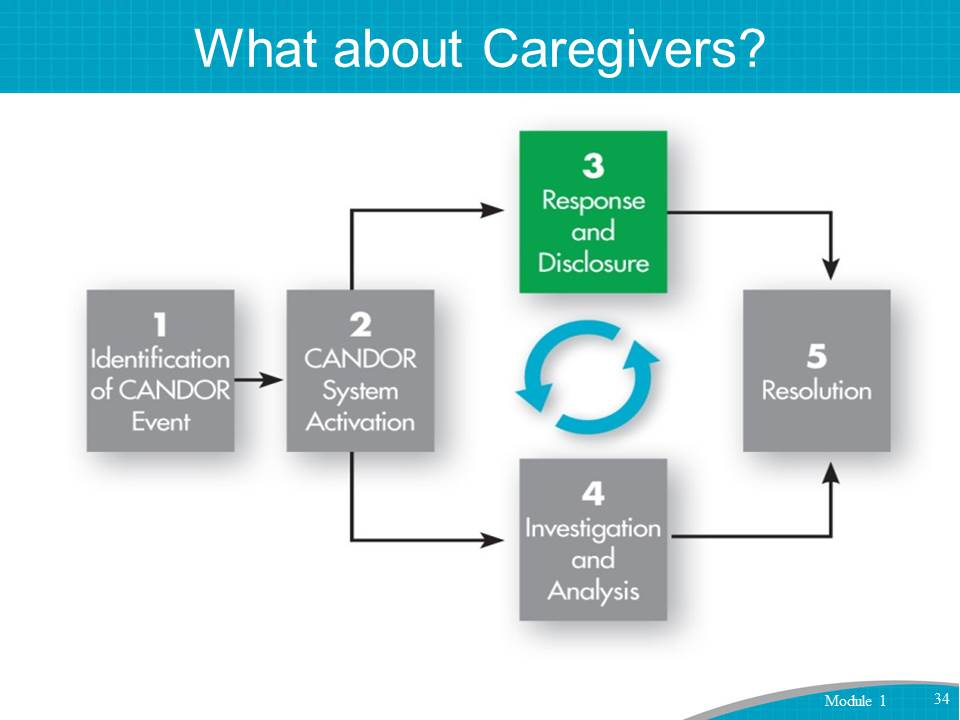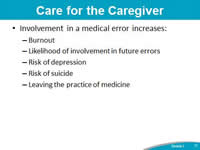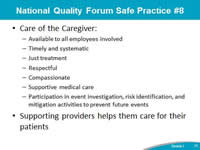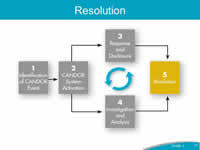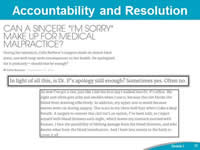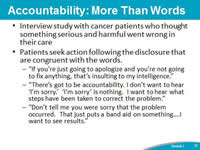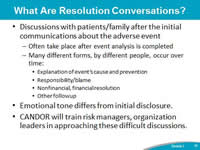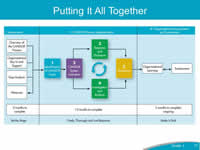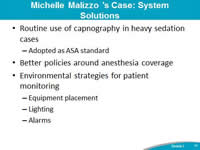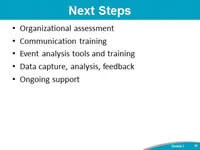Grand Rounds Presentation
AHRQ Communication and Optimal Resolution Toolkit
|
Say: This presentation will introduce you to Communication and Optimal Resolution, or the CANDOR process. Some organizations struggle to improve the way they and their care teams respond to medical harm. The CANDOR process aims to change that. |
Slide 1 |
|
Say: To get started, let's watch this video. Video: Do Less Harm |
Slide 2 |
|
Say: Today's Presentation Goals are to:
|
Slide 3 |
|
Say: All of us in health care want to provide excellent, high-quality medical care, but despite all of our patient safety work, patient harm is too common. |
Slide 4 |
|
Say: From the book "To Err is Human," as reported from the 2010 Medicare data:
|
Slide 5 |
|
Say: We haven't made headway on safety, in part because we've struggled with transparency. In this Health Affairs article, doctors report they don't always disclose medical errors. In Rosemary Gibson's book: |
Slide 6 |
|
Say: Consequences are high when organizations and health care providers don't respond to medical injury. As we saw in the Do Less Harm Video, families reported how the silence they experienced after the adverse event actually compounded the injury from the event itself. When an organization or a care provider doesn't communicate, or the communication doesn't meet the patients' or families' expectations, it may lead to litigation as patients and families see this as their only way of getting answers to their questions. |
Slide 7 |
|
Say: Open and honest communication after an adverse event is not easy and does require training and support. It starts with answering the question: "What do we know?"
It is also important to recognize not only patients' and families' emotions at the time, but also the caregivers' emotions, and to provide emotional support. It is important to remember what patients want in our communication with them:
|
Slide 8 |
|
Say: It is important to recognize why organizations and care providers are resistant to this type of open and transparent communication. Fear of:
Benefits from an open and transparent culture include:
|
Slide 9 |
|
Say: Example case. Michelle Malizzo-Ballog, pictured here with her mother and father. |
Slide 10 |
|
Say: Michelle was to have an endoscopic gastrointestinal procedure under heavy-moderate sedation, due to a failed procedure 2 weeks prior. Anesthesia was scheduled to be present for this procedure, but due to other emergencies, the GI physician was late. When he arrived, anesthesia was no longer available. The physician decided to proceed and perform the procedure, anyway. The nursing staff in the room had Michelle connected to a monitor and monitored her heart rate, blood pressure, and oxygen saturation, but due to the patient’s position for the procedure and the equipment, they had a hard time actually seeing the monitoring equipment. The physician doing the procedure asked the nurse responsible for monitoring Michelle’s vitals to get him a different piece of equipment that was not in the room during the procedure. |
Slide 11
|
|
Say: The nurse did as requested; when she returned, the nurse realized the patient was shaking. Her initial thoughts were that Michelle was having a seizure resulting in respiratory distress. After turning on the lights and performing an assessment, the team realized the patient was in cardiopulmonary arrest. The team immediately placed a call to the risk management department, and they responded immediately to the GI lab. This immediate response ensured that the critical data regarding the room, environment, and supplies were preserved and documented to help with the analysis of the event. |
Slide 12
|
|
Say: The response to medical injury involves more than just what to do and what we say to the patient. The CANDOR process is an integrated approach that involves different pieces; but for the process to work well, it centers on communication. |
Slide 13
|
|
Say: The CANDOR process is an approach that health care institutions and practitioners can use to respond in a timely, thorough, and just way to unexpected patient harm events. |
Slide 14
|
|
Say: The first step in implementing the CANDOR process is for the organization to assess organizational readiness for change. |
Slide 15
|
|
Say: To assess readiness for change, the organization should conduct a Gap Analysis. The Gap Analysis is a review of the organization to determine what processes, policies, and systems are currently in place and what will need to be changed or created to implement the CANDOR process. |
Slide 16
|
|
Say: A good response to adverse events really hinges on knowing about them immediately. Our typical human reflex is not only to not necessarily be open with patients but also not to be honest with the organization when an adverse event occurs. The statement “We can’t fix what we don’t know about” is never more true than when implementing the CANDOR process. The process starts with identifying and reporting the event. |
Slide 17
|
|
Say: Organizations that are implementing the CANDOR process need to emphasize the importance of reporting and remove the stigma attached to reporting. Once the report is received, the organization that has implemented the CANDOR process will activate the CANDOR system to ensure that:
Readiness requires both the capability to make changes and the motivation to change. Items for discussion:
|
Slide 18
|
|
Say: Once the CANDOR system is activated, two processes are occurring at the same time:
|
Slide 19
|
|
Say: The CANDOR process involves a thorough investigation of the adverse event; but in the old paradigm, the goal of investigation was "who/what can we blame for this error?" In this new paradigm, the focus of the event investigation is process improvement and conducting the investigation with a human factors approach. Best practices related to event investigations are:
The goal of these investigations is to:
|
Slide 20
|
|
Say: Example case.
|
Slide 21
|
|
Say: For an organization to be successful in getting event reports, the organization must have a Just Culture. Just Culture principles are a crucial accompaniment to the CANDOR process framework and will spark the shared accountability that is necessary for the CANDOR process implementation to be successful. If a Just Culture is so important to an organization’s culture, why do we still focus on blame? In a Just Culture, not only is shared responsibility the norm, but a commitment to eliminating harm resulting from error is widespread within the culture. This is a cornerstone of the CANDOR process of investigating the root cause of how an error occurred, including the human factors. The entire organization must support this culture change. |
Slide 22
|
|
Say: Safety Attitudes:
|
Slide 23
|
|
Say: Eliminating human error is a futile goal, as it is not a realistic approach.
|
Slide 24
|
|
Say: Human factors engineering is about redesigning the system within which humans work, as we don’t redesign humans. This approach is used in the aviation industry, and it is part of the safety culture in health care organizations. Another example of redesigning systems within which humans work is the field of ergonomics; as we work more at desks and computers, these areas are redesigned to help prevent injuries from working in this environment. This approach should be part of the safety culture in health care organizations. |
Slide 25
|
|
Say: The CANDOR process promotes the involvement of patients and families throughout the process. This concept can be very concerning for organizations, but the CANDOR process will help to address these issues.
|
Slide 26
|
|
Say: The culture of the CANDOR process provides the opportunity for continuous learning after the resolution of a CANDOR event. The information feeds into the organization’s metrics, allowing for clarification and improvement of the CANDOR processes and preventing similar harm events from occurring in the future. |
Slide 27
|
|
Say: Communication is at the heart of the CANDOR process. But the communication needs to be tailored for the audience and engaged in by individuals who understand the art of communication and have received communication training. Communication with the patient and family needs to be honest, open, and truthful and contain the facts of what is known at that moment. But it has to convey empathy and sincerity. Communication with the caregivers involved in the event needs to be supportive and ongoing. |
Slide 28
|
|
Say: In the CANDOR process, there is training for CANDOR Communication Leads, as not everyone is a good communicator. We all can identify who is a good communicator and who we would want to give us difficult or bad news. These disclosure conversations can be emotionally difficult, not only for the patient and family, but also for clinician communicating with the patient/family. Not all clinicians should be conducting this initial communication with patients/families. It is important that, as part of the CANDOR process, clinicians reach out to the CANDOR Communication Leads to enlist help with these conversations. |
Slide 29
|
|
Say: Let’s watch this video, as it demonstrates what happens when communication is not handled well. |
Slide 30
|
|
Say: What we have learned from patients and families after a serious harm event is that every hour that goes by without effective communication results in additional harm to the patient/family. It is important that communication with the patient and family is planned and structured to meet the goals of the patient and family. Keys to remember about the disclosure:
Organizational leadership and support for the CANDOR process are key to ensure that it occurs. |
Slide 31
|
|
Say: Additional tips to help the disclosure conversation:
Use your resources,and get help in preparing for these conversations—Your organization may developa process related to disclosure, and it is important to follow that process. |
Slide 32
|
|
Say: As we can see from the data, there is still work to be done in open and transparent communication. The CANDOR process can help clinicians and organizations feel more comfortable with the act of disclosure, and patients and families will have communication that meets their expectations. |
Slide 33
|
|
Say: When the organization responds to the event, part of the CANDOR process Response is the activation of the organization’s Care for the Caregiver program. |
Slide 34
|
|
Say: Involvement in a medical error can increase a clinician’s:
|
Slide 35
|
|
Say: In addition to the organization Medically Induced Trauma Support Services (or MITSS), the National QualityForum has published guidance in a “safe practice” on caring for caregivers after an adverse event. It explains that after an adverse event, regardless of whether it is due to human or system error, all employees involved (including administrators, clinical providers, and other staff), should receive care. It should be timely, systematic, just, respectful, and compassionate. If needed, supportive medical care should be offered, and the involved employees should be offered the ability to meaningfully participate in the event investigation, in hopes that they contribute to efforts designed to preventfuture events. An organization that implements the CANDOR process must support not only the patients/families affected by an adverse event, but also the providers who care for patients/families. |
Slide 36
|
|
Say: Resolution can be defined as the act of solving a problem, dispute, or contentious matter. In the CANDOR process, this definition applies as well, but resolution does not equate to a financial settlement. Rather, resolution is a process that addresses patients’ expectations. Resolution should lead to a settlement of issues related to the adverse event,but doesn’t always lead to a financial settlement. |
Slide 37
|
|
Say: In a September 27, 2013, column in Elle, journalist Celia Barbour chronicled her experience having a vein nicked during arm surgery, an injury that nearly killed her (http://www.elle.com/beauty/health-fitness/medical-malpractice-personal-essay). The surgeon gave her an immediate and sensitive apology for the error, accepting full responsibility. But no one offered her compensation, beyond the surgeon waiving his portion of the bill. She hasn’t sued—yet—but months later, she still struggles with whether the apology was enough. This story illustrates the progress we’ve made toward accountability for error in medical care…and also what we haven’t yet been able to do for injured patients, which is to proactively offer just compensation. |
Slide 38
|
|
Say: The concept of accountability relates to what patients want, following an adverse event, from their care providers and from the organization. Patients want:
Patients are looking for the actions the organization is taking to prevent and learn from the adverse event. |
Slide 39
|
|
Say: Resolution can truly occur only after the organization has completed its investigation and analysis of the event. Remember that disclosure is a process, and the first step is to:
|
Slide 40
|
|
Say: The implementation of the CANDOR process can be broken down into three major buckets:
|
Slide 41
|
|
Say: It is important to keep patients and families who were involved in a medical error at your organization involved in the process of improving patient safety at the organization. |
Slide 42
|
|
Say: Example case.
|
Slide 43
|
|
Say: Next steps for your organization:
|
Slide 44
|
|
Say: Questions? |
Slide 45
|






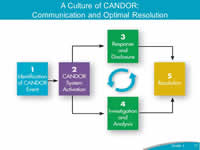
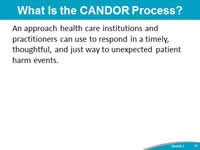
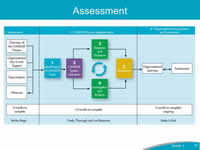
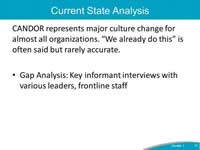

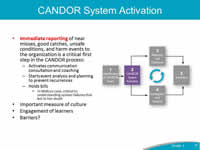
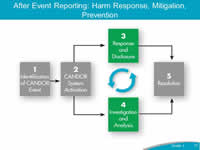
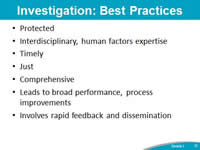
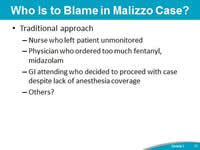
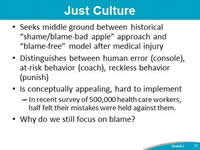
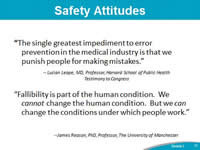
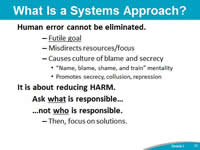

![Involving Patients in Post-Event Learning. '[Patients] know our systems probably better than we know our systems because they have been through them so much.' 'The whole investigation process is incomplete when you don’t involve [patients].' 'Patients and families could offer a unique perspective on norms and quality of care that would otherwise be lost.' Patients may not know enough about health care systems – The CANDOR process encourages you not to make assumptions, and to interview patients and families to get their perspective on the event. Concerns about legal protections – Invite patients in appropriate settings (i.e., patient-safety committees), determine local QI privileges and share this information with caregivers. Further distress to the family – Timing matters; but if you are open and continuously communicating with the patient and family, the organization will know the right time to approach them. Best way to involve patients and family – Provide various options, because not every patient/family will want the same thing. Having options allows them to select what works best.](/sites/default/files/wysiwyg/professionals/quality-patient-safety/patient-safety-resources/resources/candor/grandrounds/slide26.jpg)
